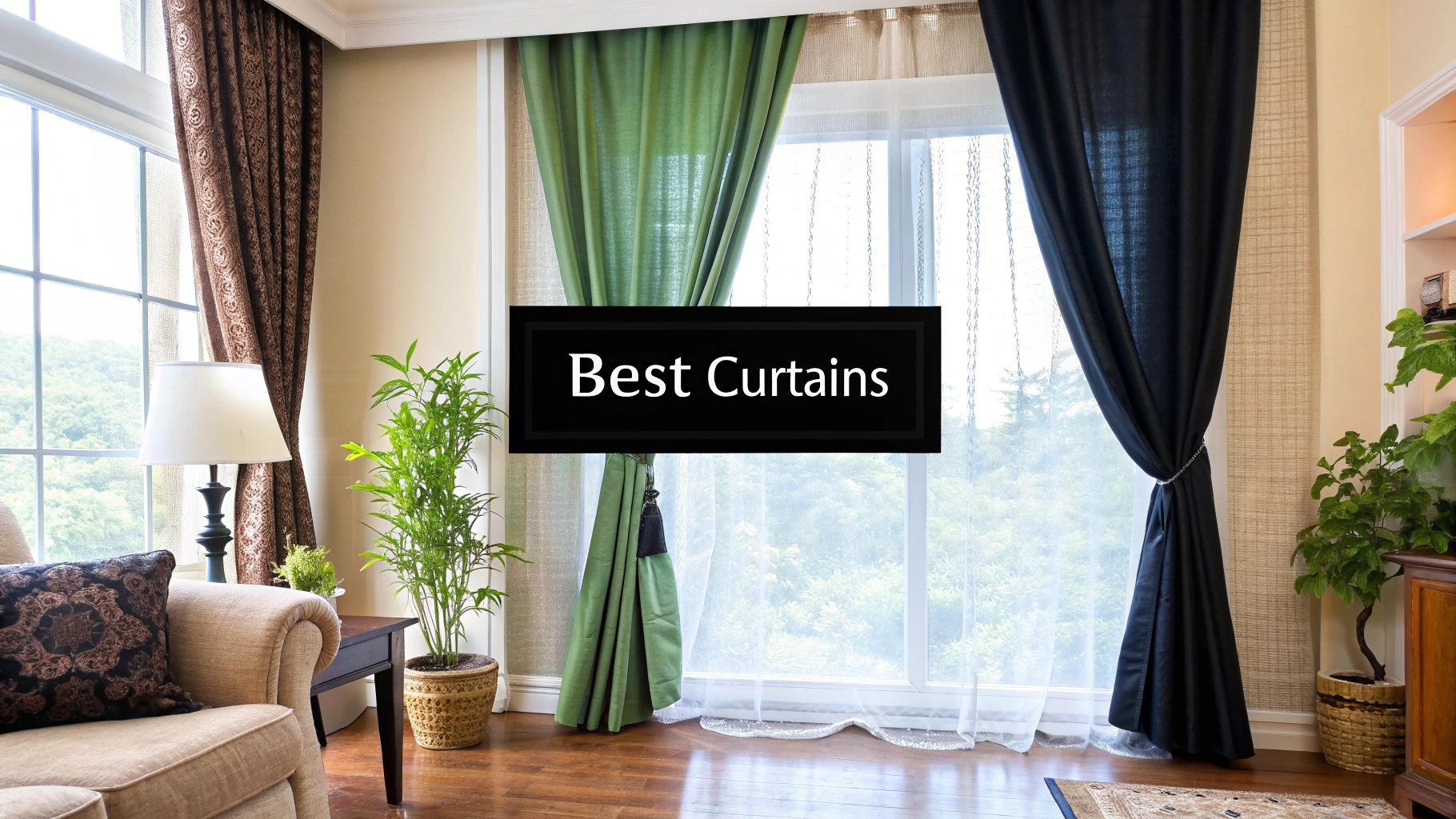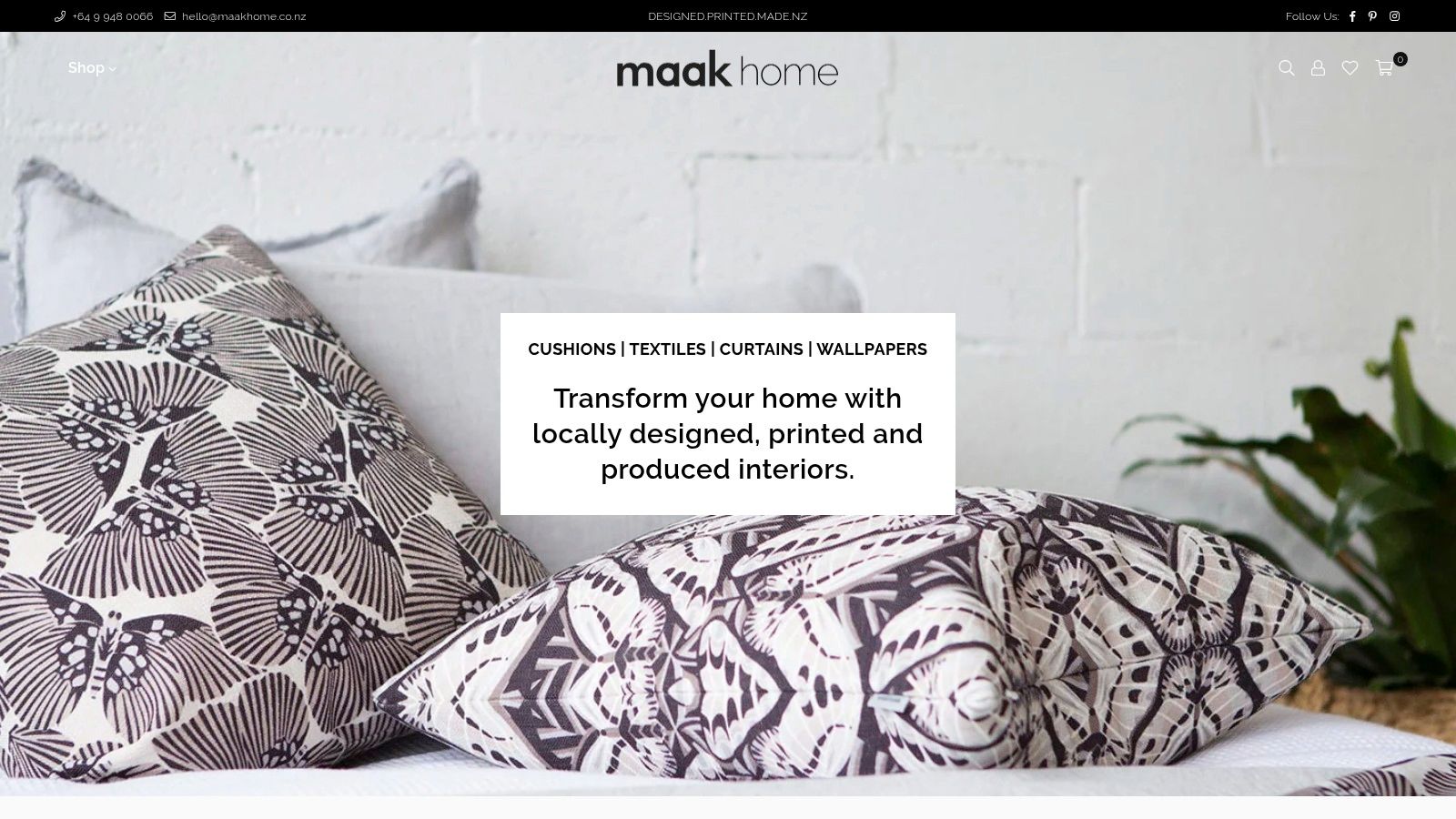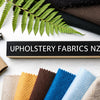Top 7 Best Curtain Material for Living Room in 2025

Transform Your Living Room with the Perfect Curtains
Choosing the best curtain material for living room can be overwhelming. This list simplifies the decision, presenting seven top options, including sustainable choices from NZ-based Maak Home. Discover the ideal fabric for your aesthetic and practical needs, whether it's light control, insulation, or simply elevating your living room's style. From versatile cotton and linen to luxurious velvet and silk, find the perfect material to transform your space. This guide will also explore linen-cotton blends and polyester options, helping you find the best curtain material for your living room project.
1. Maak Home: Sustainable Style for Your Living Room Curtains
When searching for the best curtain material for your living room, it's essential to consider factors like aesthetics, durability, and sustainability. Maak Home excels in all three, offering a unique blend of bespoke design and eco-conscious manufacturing right here in Aotearoa. Their commitment to on-demand production, using digital printing technologies and local manufacturing, sets them apart as a leading choice for environmentally aware homeowners and interior design professionals in New Zealand and Australia. They provide a truly personalized experience, allowing you to create the perfect curtains to elevate your living room’s ambiance.

Maak Home's dedication to sustainability goes beyond simply using eco-friendly materials. Their zero-waste production model, enabled by on-demand digital printing, ensures that fabrics are printed only when ordered. This eliminates excess inventory and significantly reduces the environmental impact compared to traditional textile manufacturing. This makes them a particularly appealing option for those seeking the best curtain material for a living room designed with sustainability in mind. For Kiwis looking to support local businesses while minimizing their carbon footprint, choosing Maak Home is a win-win. Plus, with free shipping across both New Zealand and Australia, bringing beautiful, sustainable design into your home is both convenient and cost-effective.
Their extensive range of fabrics offers diverse choices for the best curtain material for any living room style. From luxurious linens to vibrant patterned cottons, you can find the perfect texture and design to complement your existing décor. Learn more about Maak Home and discover how their curated collections can inspire your interior design vision. Fabric prices start from $35 per meter, providing a range of options depending on your chosen material and specific requirements. This allows you to tailor your choice to suit your budget while still maintaining a focus on quality and sustainability.
Beyond their standard fabrics, Maak Home offers bespoke printing services, providing even greater flexibility for those seeking a truly unique touch. Imagine transforming a cherished family photo or a piece of original artwork into the focal point of your living room curtains. This level of customization allows you to create a space that reflects your personality and style like no other. While this bespoke service sits at a premium price point, the ability to create one-of-a-kind curtains makes it a worthwhile investment for those seeking the best curtain material that embodies their individual vision.
For interior designers and architects, Maak Home’s online platform provides a seamless digital textile studio experience. The ability to browse fabrics, order samples, and manage projects online streamlines the design process, making it easier than ever to incorporate sustainable, locally made textiles into client projects. Commercial property developers and hospitality businesses can also benefit from Maak Home’s custom printing capabilities, creating bespoke curtains and other interior elements that align with their brand identity and contribute to a unique customer experience.
However, it's important to be aware of the potential lead times associated with on-demand production. While off-the-shelf curtains might offer quicker delivery, the wait for Maak Home’s custom-created pieces is an investment in quality and sustainability. Planning ahead and factoring in potential production time is crucial, especially for time-sensitive projects.
Pros:
- Sustainable and ethical: Zero-waste production with on-demand digital printing minimizes environmental impact.
- Locally made: Designed, printed, and manufactured in New Zealand, supporting local industry.
- Wide product variety: Extensive fabric choices with various finishes cater to diverse tastes and needs.
- Free shipping: Convenient and cost-effective delivery within New Zealand and Australia.
- Customer-focused: Quality assurance guarantee ensures satisfaction.
Cons:
- Premium pricing: May not be suitable for all budgets, particularly for bespoke printing.
- Longer lead times: On-demand production requires more time compared to ready-made options.
If you prioritize quality, sustainability, and supporting local businesses, Maak Home is an excellent option when choosing the best curtain material for your living room. Their commitment to eco-conscious practices, coupled with their diverse range of fabrics and bespoke printing options, provides a unique opportunity to create a stylish and sustainable living space that truly reflects your personal aesthetic.
2. Cotton
Cotton is a perennial favourite for living room curtains in New Zealand homes, and for good reason. This natural fibre offers a blend of versatility, classic appeal, and practicality that makes it a strong contender for the title of best curtain material for living room spaces. From light and airy voiles that gently filter sunlight to heavier canvas weaves that provide substantial privacy and light blockage, cotton caters to a wide range of needs and aesthetic preferences. Its inherent breathability makes it suitable for New Zealand's varied climate, ensuring comfortable living room temperatures year-round. Furthermore, cotton's excellent drapability allows it to fall in elegant folds, adding a touch of sophistication to any window treatment.

One of the biggest advantages of choosing cotton for your living room curtains is its versatility. Available in a wide array of weights, from sheer to blackout, cotton allows you to control the amount of light and privacy in your space. Lightweight cotton voiles are perfect for creating a bright and airy ambience, diffusing sunlight softly throughout the room. For those seeking more privacy or light control, heavier cotton weaves, including canvas and twill, offer excellent blackout capabilities, making them ideal for media rooms or bedrooms. This adaptability makes cotton a particularly attractive option for interior designers and architects working on projects in New Zealand and Australia, where maximizing natural light while maintaining privacy is often a key consideration.
Cotton's easy maintenance is another significant benefit. Unlike some delicate fabrics, cotton curtains are generally machine washable, simplifying upkeep and ensuring long-lasting freshness. For busy homeowners and hospitality businesses, this ease of care is invaluable. Moreover, cotton readily accepts dyes, resulting in vibrant, long-lasting colours that cater to diverse design schemes. This makes cotton a practical choice for commercial property developers and fit-out contractors who need durable and aesthetically pleasing window treatments.
For the eco-conscious homeowner, cotton’s natural and hypoallergenic properties are a major draw. As a biodegradable and renewable resource, cotton is a sustainable choice for those seeking to minimize their environmental impact. Its hypoallergenic nature also makes it a suitable option for individuals with sensitivities. DIY home decorators and craft enthusiasts will also appreciate cotton's versatility for custom projects, from dyeing and printing to creating unique embellishments.
While cotton offers numerous advantages, it's important to be aware of its potential drawbacks. Untreated cotton can be prone to wrinkling, and some types may shrink if not pre-shrunk. Additionally, cotton can fade over time with prolonged sun exposure, particularly in brightly lit New Zealand living rooms. However, many cotton curtains are now treated for enhanced durability, wrinkle resistance, and fade resistance, mitigating these issues. Before purchasing, check the fabric care instructions to ensure the curtains are pre-shrunk and treated for UV protection.
Pricing for cotton curtains varies depending on the weight, weave, and finish. Generally, cotton is an affordable and widely available option, making it accessible to a range of budgets. Learn more about Cotton to determine the right measurements for your living room windows. This is essential for achieving the desired drape and ensuring your new curtains fit perfectly. When considering the best curtain material for living room applications, cotton stands out as a versatile and practical choice for a wide range of needs and styles. Its natural breathability, easy maintenance, and affordability make it a popular option for New Zealand homes. By understanding the different weights, weaves, and finishes available, you can choose the perfect cotton curtains to enhance the beauty and functionality of your living room. More information on the versatility of cotton can be found at https://www.cottoninc.com.
3. Linen
Linen curtains are a top contender for the best curtain material for living rooms, offering a unique blend of natural elegance and casual sophistication. Their distinctive texture and light-filtering abilities create an airy, comfortable atmosphere perfect for a variety of interior design styles, particularly modern and coastal schemes, which are popular choices in NZ homes. Woven from flax fibers, linen provides a relaxed, lived-in aesthetic that adds a touch of understated luxury to any living space. This makes them a sought-after choice amongst interior designers, architects, and discerning homeowners in New Zealand and Australia who appreciate natural materials and sophisticated design.
The inherent beauty of linen lies in its natural texture. Unlike smooth, uniform fabrics, linen possesses a subtle, irregular weave that adds visual depth and interest to your living room. This textured weave also plays a role in the fabric's excellent light-filtering properties. Linen curtains diffuse sunlight softly, reducing glare without completely blocking out natural light. This creates a warm and inviting ambiance while maintaining privacy, making them an excellent choice for living rooms that receive ample sunlight. For those looking to create a truly tranquil and calming atmosphere, layering sheer linen curtains with heavier drapes can offer both light control and aesthetic appeal.
Beyond aesthetics, linen offers several practical advantages. Flax, the source of linen fibers, is a naturally breathable material. This quality makes linen curtains ideal for warm climates like those experienced in parts of New Zealand and Australia. They allow for excellent air circulation, keeping your living room cool and comfortable during the warmer months. Additionally, linen is naturally antimicrobial and moisture-wicking, further contributing to a healthy and comfortable indoor environment. These qualities also make linen a practical choice for hospitality businesses such as hotels, cafés, and restaurants, where maintaining a fresh and inviting atmosphere is paramount.
Durability is another key advantage of linen. It’s a strong, long-lasting material that becomes softer and even more beautiful with age. While a higher initial investment compared to cotton, linen's durability means your curtains will withstand the test of time, making it a worthwhile investment for homeowners and commercial property developers alike. Learn more about Linen and its sustainability credentials, which are becoming increasingly important for eco-conscious consumers. Linen's longevity and biodegradability make it a responsible choice for those seeking to minimise their environmental impact.
While linen offers a multitude of benefits, it's important to be aware of its drawbacks. One of the most noticeable characteristics of linen is its tendency to wrinkle. While some find this relaxed, rumpled look appealing, others might prefer a more crisp and formal appearance. If you're not a fan of the wrinkled aesthetic, be prepared to iron your linen curtains regularly. Steaming is another effective method for smoothing out wrinkles and maintaining a fresh look.
Another consideration is the price. Linen typically sits at a higher price point than cotton or synthetic alternatives. This is due to the labour-intensive process of cultivating and processing flax fibers. However, the superior quality, durability, and unique aesthetic of linen often justify the higher cost for those seeking a premium, long-lasting window treatment. Finally, due to the nature of the natural fibers, linen curtains are often available in a more limited range of colours compared to synthetic fabrics. This is something to keep in mind when coordinating your curtains with your existing décor. However, the natural hues of linen often complement a variety of interior design styles, creating a sense of timeless elegance.
For DIY home decorators and craft enthusiasts, working with linen can present a unique set of opportunities and challenges. Its natural texture lends itself beautifully to handcrafted details and embellishments. However, its tendency to fray requires careful handling and precise stitching.
Choosing the best curtain material for your living room involves balancing aesthetics, functionality, and budget. Linen curtains, with their natural elegance, breathability, and durability, are a strong contender for those seeking a sophisticated and sustainable option. Check out more details at Masters of Flax. While the higher price point and tendency to wrinkle may be deterrents for some, the unique charm and long-lasting quality of linen make it a worthwhile investment for many New Zealand homeowners.
4. Polyester
Polyester stands as a prominent contender when considering the best curtain material for living rooms, particularly in the diverse climates of New Zealand and Australia. Its practicality, affordability, and impressive durability make it a popular choice for both residential and commercial spaces. From Auckland villas to Melbourne apartments, polyester curtains offer a versatile and budget-friendly solution for window treatments.
This synthetic fabric is engineered for performance, boasting excellent resistance to wrinkles, fading, and shrinking. Unlike natural fibers like linen or cotton, polyester maintains its structural integrity over time, ensuring consistent performance and a crisp, fresh appearance even after multiple washes. This durability translates into long-term cost savings, making it an attractive option for homeowners and businesses alike. Moreover, modern polyester manufacturing techniques have yielded fabrics that can convincingly mimic the look and feel of more expensive natural materials, offering a sophisticated aesthetic without the premium price tag.
For eco-conscious homeowners in New Zealand and Australia, polyester offers a surprising advantage. While not inherently a sustainable material, the longevity of polyester curtains reduces the need for frequent replacements, minimizing textile waste. Furthermore, some manufacturers are incorporating recycled PET plastic into their polyester production, offering a more environmentally friendly alternative.
Features and Benefits for Various Applications:
Polyester's versatility makes it suitable for a wide range of applications:
-
Residential Living Rooms: In homes, polyester curtains provide easy care and durability, ideal for busy families and high-traffic areas. The wide variety of colours, textures, and finishes available allows for seamless integration with any interior design scheme. For light-sensitive sleepers, blackout polyester curtains offer excellent light-blocking capabilities, promoting restful sleep. Similarly, thermally insulated polyester curtains can contribute to energy efficiency by reducing heat loss in winter and heat gain in summer, a particularly valuable feature in the variable climates of NZ and Australia.
-
Commercial Spaces: In commercial settings such as hotels, cafes, and restaurants, polyester's durability and ease of maintenance are highly valued. Its fire-retardant properties are also a crucial safety consideration in these environments. The ability to customize polyester with specific finishes allows businesses to tailor their window treatments to their branding and ambience. For instance, a restaurant might choose a textured polyester that mimics the look of linen for a sophisticated feel, while a hotel might opt for blackout curtains to ensure guest comfort.
-
DIY Decorators and Craft Enthusiasts: Polyester's affordability and ease of sewing make it a popular choice for DIY projects. It drapes well and holds its shape, making it suitable for creating custom curtains, roman shades, and other window treatments. The readily available variety of colours and patterns empowers creative individuals to personalize their living spaces.
Pricing and Technical Requirements:
Polyester curtains are generally very affordable, making them a budget-friendly option compared to natural fiber alternatives like silk or linen. Prices vary depending on the fabric weight, weave, finish, and any added features like blackout or thermal coatings. You can find polyester curtains at various price points in NZ and Australian retail stores, ranging from budget-friendly options at large chain stores to more specialized designs at boutique home décor shops. Installation typically involves standard curtain rods and hardware, requiring no specialized technical skills.
Comparison with Similar Materials:
Compared to cotton, polyester offers superior wrinkle resistance and durability. While linen provides a more natural and breathable feel, it requires more care and is prone to wrinkling. Silk offers a luxurious drape but comes with a significantly higher price tag and requires delicate cleaning. For practical applications where durability and ease of maintenance are priorities, polyester outperforms these alternatives.
Implementation and Setup Tips:
- Measuring: Accurate measurements of your windows are crucial for a proper fit. Measure the width and height of the window frame and add extra width for fullness and proper coverage.
- Hanging: Use appropriate curtain rods and hardware for the weight and style of the curtains. Consider the desired curtain fullness when selecting the rod width.
- Care: Polyester curtains are typically machine washable, but always refer to the manufacturer's care instructions. Line drying is recommended to prevent shrinkage and maintain the fabric's integrity.
Polyester's blend of affordability, durability, and versatility solidifies its position as a top choice for living room curtains in New Zealand and Australia. Whether you’re a homeowner seeking a practical and stylish window treatment, a commercial property developer looking for cost-effective solutions, or a DIY enthusiast exploring creative possibilities, polyester offers a reliable and adaptable material to meet your needs. For more detailed information on polyester fiber, visit www.polyesterfiber.org.
5. Silk
Silk curtains are often considered the pinnacle of luxury when choosing the best curtain material for your living room. Their lustrous sheen and fluid drape lend an air of unmatched elegance to any space, making them a popular choice for discerning homeowners in New Zealand and Australia. This natural protein fiber offers not just aesthetic appeal but also practical benefits, making it a worthy contender on this list. Whether you're an interior designer working on a high-end project or an eco-conscious homeowner seeking natural materials, understanding the nuances of silk can help you make an informed decision.
Silk’s luxurious appeal comes from its unique composition. As a natural protein fiber produced by silkworms, it possesses a natural shimmer and a smooth, soft texture. This translates to a beautiful drape and a luxurious feel that elevates the entire living room aesthetic. Beyond the visual appeal, silk offers excellent insulation properties, keeping your living room warm in winter and cool in summer. This natural thermal regulation makes it a practical choice for the variable New Zealand climate. Furthermore, silk is naturally hypoallergenic and resistant to dust mites, a significant advantage for those with allergies or sensitivities.
For New Zealand homeowners, the versatility of silk is a key benefit. It’s available in a range of weights and weaves, from delicate silk voiles that filter light beautifully to heavier silk dupioni that offers more privacy and light blockage. This adaptability allows silk to complement both formal and casual living spaces. Imagine sheer silk panels framing a window with a view of the stunning New Zealand landscape, softly diffusing the sunlight while maintaining the connection to the outdoors. Alternatively, envision rich silk dupioni curtains adding a touch of grandeur to a formal living room, creating a sense of opulence and sophistication.
From a design perspective, silk offers superior color saturation and depth compared to synthetic fabrics. This means that colors appear richer and more vibrant on silk, allowing for greater impact in your living room’s design scheme. Whether you're aiming for a bold statement or a subtle accent, silk curtains can deliver the desired effect.
However, the luxury of silk comes at a price. The initial investment for silk curtains is significantly higher than other materials like linen or polyester. This is due to the complex production process and the inherent value of the natural fiber. Pricing can vary significantly depending on the type of silk, the weave, and the origin, but expect to pay a premium for genuine silk. You may find prices ranging from NZD $500 to upwards of NZD $2000+ for a pair of ready-made silk curtains, and custom-made options can be significantly more expensive.
Maintenance can also be a consideration. Silk typically requires professional cleaning or careful hand washing using a mild detergent. Direct sunlight can damage the delicate fibers, causing fading and weakening over time, so consider lining your silk curtains or using them in rooms with indirect light. Additionally, silk can water spot if not properly treated, making it essential to address spills immediately and carefully.
Compared to linen, another natural fiber often used for curtains, silk offers a more luxurious look and feel, but comes with a higher price tag and greater maintenance requirements. Linen is known for its durability and relaxed aesthetic, while silk exudes elegance and sophistication. Polyester, a synthetic option, is significantly more affordable and easier to maintain than silk but lacks the same luxurious sheen and drape. For those seeking a balance between luxury and practicality, a silk-linen blend can be an excellent compromise.
When implementing silk curtains in your living room, consider using a professional installer to ensure the correct hanging and draping. Lining your curtains will not only protect them from sun damage but also enhance their insulation properties and drape. If you're working with a limited budget, consider using silk panels for accent windows or combining them with less expensive materials for larger windows.
For commercial spaces in New Zealand and Australia, silk curtains can add a touch of elegance to hospitality venues like hotels, cafés, and restaurants. They create a sophisticated atmosphere that complements high-end décor and enhances the overall guest experience. For architects and interior designers, silk provides a luxurious material option that can elevate any residential or commercial project. However, it’s crucial to factor in the higher cost and specific maintenance requirements when specifying silk curtains.
Ultimately, silk curtains offer a unique combination of luxury, beauty, and functionality. While the higher price point and specific care instructions may require more investment, the unparalleled elegance and natural benefits of silk make it a worthwhile consideration for those seeking the best curtain material for their living room. For New Zealand homeowners who appreciate quality and craftsmanship, silk curtains represent a timeless investment that will enhance the beauty and comfort of their living space for years to come. Further information on silk can be found at https://www.silk.org.
6. Velvet
When considering the best curtain material for your living room, velvet offers a touch of undeniable luxury and drama that few other fabrics can match. Its rich texture and depth of colour create an intimate and sophisticated atmosphere, making it a popular choice for those seeking to elevate their living space. Beyond its aesthetic appeal, velvet boasts practical benefits such as excellent light-blocking capabilities and superior sound absorption, making it a versatile option for various living room settings. This makes it particularly appealing for New Zealand homes, where managing both light and sound can be key for creating a comfortable and inviting space.

Traditionally made from silk, velvet is now widely available in more affordable and durable options such as cotton or synthetic blends. This allows a broader range of homeowners and interior designers to incorporate this luxurious material into their projects. For eco-conscious homeowners in New Zealand and Australia, exploring organic cotton velvet options provides a sustainable and stylish choice.
The dense pile construction of velvet is what gives it its superior light-blocking properties, making it an excellent choice for bedrooms or living rooms where light control is paramount. These blackout capabilities also contribute to enhanced privacy, shielding your living space from prying eyes. Moreover, this dense pile also provides excellent sound absorption and acoustic properties, dampening external noise and creating a more tranquil environment within your living room. This feature can be especially beneficial in bustling urban environments or homes situated near busy roads. Velvet's thermal insulation capabilities further add to its practicality, helping to regulate the temperature of your living room and potentially reducing energy costs. In the cooler New Zealand months, velvet curtains can help retain heat, while in summer they can help keep your living room cool.
For interior designers and architects working on commercial projects in New Zealand and Australia, velvet curtains can be a striking addition to hospitality spaces such as hotels, cafes, and restaurants. Their luxurious appearance can instantly elevate the ambiance of these establishments, creating a sense of opulence and sophistication. The sound-dampening qualities of velvet also make it a practical choice for these environments, helping to control noise levels and create a more pleasant atmosphere for guests.
While velvet offers many advantages, it's important to consider its maintenance requirements. Velvet can attract and hold dust and pet hair, necessitating regular cleaning. Vacuuming with a brush attachment is generally recommended for routine cleaning. Professional cleaning may be required for more thorough cleaning or stain removal. Learn more about Velvet for insights on current trends and care tips. Additionally, due to its heavier weight, velvet curtains may require reinforced curtain rods for proper support. This is particularly important to consider during the planning stages of renovations or new builds. Finally, velvet tends to be more expensive than basic fabric options like cotton or linen. However, its durability, aesthetic appeal, and practical benefits often justify the higher price point, making it a worthwhile investment for those seeking a long-lasting and luxurious window treatment.
While pricing can vary depending on the fibre content (silk being the most expensive, followed by cotton and then synthetics), the quality of the weave, and the retailer, expect to pay a premium for velvet curtains compared to more standard options. Check with local suppliers like Mohawk Group (https://www.mohawkgroup.com) for specific pricing and availability in your area. When selecting velvet curtains, consider the weight and drape of the fabric. Heavier velvets will provide better light blocking and sound absorption, while lighter velvets offer a more flowing, less formal look.
For DIY home decorators and craft enthusiasts, working with velvet can present some challenges due to its thickness and tendency to fray. Using sharp scissors and taking precise measurements are crucial when cutting and sewing velvet. Consider using a walking foot on your sewing machine to ensure even feeding of the fabric.
By carefully weighing the pros and cons, you can determine if velvet is the right choice for your living room and create a truly elegant and comfortable living space.
7. Linen-Cotton Blend
When searching for the best curtain material for your living room, a linen-cotton blend offers a compelling compromise, capturing the desirable qualities of both fibres. This blend, typically composed of 50-70% linen combined with cotton, delivers the airy, natural aesthetic of linen with the easy care of cotton. This makes it a strong contender for living rooms in New Zealand and Australia where practicality meets style. It presents an excellent middle ground for those seeking a natural, breathable fabric that's also manageable in terms of upkeep.

For interior designers working on residential projects in NZ, specifying linen-cotton blend curtains can satisfy clients seeking a sophisticated look without the high maintenance of pure linen. The fabric drapes beautifully, offering a relaxed yet refined ambiance, perfectly suited to the Kiwi lifestyle. Architects designing eco-conscious homes will appreciate the blend's natural breathability, contributing to a healthier indoor environment. These curtains allow for good airflow, promoting ventilation while filtering light softly. This blend also aligns with the growing preference for natural materials in Australian and New Zealand homes.
DIY decorators and craft enthusiasts will find this fabric a joy to work with. It's less prone to excessive wrinkling than pure linen, simplifying the sewing process and making it easier to achieve a polished finish. For commercial spaces, such as boutique hotels, cafes, and restaurants in NZ, linen-cotton blend curtains provide a stylish and durable solution. The fabric can withstand frequent washing and maintain its colour integrity over time, essential for high-traffic environments. Fit-out contractors working on hospitality projects can leverage the blend’s durability and aesthetic appeal to create inviting spaces.
While pricing can vary depending on the specific blend and retailer, linen-cotton generally sits in a mid-range price bracket. It’s more affordable than pure linen but more expensive than pure cotton or synthetic alternatives. For example, you might find ready-made linen-cotton curtains in NZ ranging from NZD $150 to $400 per pair, depending on size and finish. Fabric by the metre can range from NZD $30-$60 per metre. Keep in mind that custom-made curtains will incur additional costs for labour and hardware.
Caring for linen-cotton blend curtains is relatively straightforward. Most blends are machine washable, though it’s recommended to use a gentle cycle with cold or lukewarm water. Avoid harsh detergents and opt for a natural fabric softener. Line drying is ideal to preserve the fabric’s integrity and minimize wrinkles. However, if tumble drying is necessary, use a low heat setting. Ironing should be done on a medium setting while the fabric is still slightly damp.
Compared to pure linen, the cotton component reduces wrinkling significantly, contributing to the blend’s practical appeal. However, it may still wrinkle slightly more than synthetic options like polyester. While not as luxurious as pure linen or silk, the linen-cotton blend offers a good balance of durability, elegance, and ease of care. This blend is arguably a superior choice over pure cotton for living room curtains because it elevates the visual appeal with linen’s characteristic texture while retaining cotton’s easy maintenance.
To implement linen-cotton blend curtains in your living room, consider the existing décor and colour palette. Neutral shades like beige, ivory, and grey provide a versatile backdrop, while bolder colours can add a pop of personality. For a contemporary look, opt for simple grommet or eyelet headings. For a more traditional feel, consider pleated or pinch-pleated styles. Ensure accurate measurements are taken before purchasing or ordering custom-made curtains. The curtains should ideally fall to the floor or just graze it, creating a sophisticated and polished look. More information on cotton blends can be found at https://www.cottoninc.com. By carefully considering these factors, you can effectively utilize linen-cotton blend curtains to enhance the style and functionality of your living room.
Living Room Curtain Materials Comparison
| Product | Core Features & Material | User Experience & Quality ★★★★☆ | Value Proposition 💰 | Target Audience 👥 | Unique Selling Points ✨ |
|---|---|---|---|---|---|
| 🏆 Maak Home | Sustainable, on-demand digital print textiles; custom cushions, curtains, wallpapers | High quality with satisfaction guarantee | Premium prices starting at $35–$100+ | Designers, architects, homeowners, businesses | Zero-waste, local NZ manufacturing, free shipping |
| Cotton | Natural breathable fiber; varied weights; easy maintenance | Versatile & hypoallergenic | Affordable, widely available | Budget-conscious homeowners and general users | Machine washable; vibrant dye acceptance |
| Linen | Natural flax fiber; breathable with textured weave | Elegant, durable, softens over time | Mid to high price point | Style-focused homeowners; warm climates | Naturally antimicrobial and moisture-wicking |
| Polyester | Synthetic, wrinkle & fade resistant; variety of finishes | Low maintenance, durable | Very affordable | Budget buyers needing durable curtains | Can mimic natural fibers; engineered functions |
| Silk | Natural protein fiber; luxurious sheen & drape | Luxurious feel with excellent insulation | High-end, expensive | Luxury market, formal living spaces | Hypoallergenic; superior color depth |
| Velvet | Dense pile fabric; excellent light & sound blocking | Dramatic, heavy texture, high insulation | Higher price tier | Those seeking blackout/privacy and luxury | Superior acoustic & thermal insulation |
| Linen-Cotton Blend | Blend offering linen breathability with cotton durability | Balanced wrinkle resistance and care | Mid-range, more affordable than linen | Those wanting linen look with easier care | Machine washable, good color retention |
Choosing the Right Curtain Material for Your Living Room
Finding the best curtain material for your living room can transform the entire space. From the breezy elegance of linen to the luxurious drape of velvet, each material offers unique benefits. We've explored a range of options, including natural fibres like cotton and linen, durable synthetics like polyester, and opulent choices like silk and velvet, even touching on the versatile linen-cotton blend. Remember, your choice depends on a variety of factors including your desired aesthetic, light control needs, budget, and the overall ambience you want to create. For New Zealand homes, consider the specific climate and how well the material insulates against both heat and cold. Professionals such as interior designers, architects, and commercial property developers will find this guide invaluable for client projects, while DIY enthusiasts can use this information to elevate their own home décor.
Selecting the right material goes beyond just looks. Think about practicality. How easy is it to clean? Does it require special care? How well does it drape? And, especially for eco-conscious homeowners in New Zealand and Australia, consider the material’s sustainability and environmental impact. Businesses in the hospitality sector, like hotels, cafés and restaurants, should prioritise durability and fire retardancy alongside aesthetic appeal when selecting curtain materials.
For a curated selection of premium curtain fabrics and expert advice tailored to the New Zealand market, explore the offerings at Maak Home. They offer a diverse range of options to perfectly complement your living room design, including many of the materials discussed in this article. Discover the perfect drapes for your space and elevate your interior design by visiting Maak Home today.









